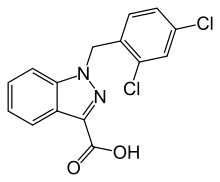All AbMole products are for research use only, cannot be used for human consumption.

Lonidamine (AF-1890) is a novel CFTR open channel blocker with an IC50 of 0.85 mM, which inhibits aerobic glycolysis in cancer cells. Lonidamine (AF-1890) is a hexokinase and mitochondrial pyruvate carrier inhibitor (Ki=2.5 μM). Lonidamine could reduce the dose of temozolomide required for radiosensitization of brain tumours. Lonidamine elicits ERK and Akt/mTOR pathway activation, as indicated by increased ERK, Akt, p70S6K and rpS6 phosphorylation, and these effects are reduced by co-treatment with the anti-leukemic agent arsenic trioxide. Lonidamine significantly extends both median and maximum lifespan of C. elegans when applied at a concentration of 5 micromolar by 8% each. Lonidamine, a dechlorinate derivative of indazole-3-carboxylic acid, has proved to exert a powerful antiproliferative effect and to impair the energy metabolism of neoplastic cells.
| Molecular Weight | 321.16 |
| Formula | C15H10Cl2N2O2 |
| CAS Number | 50264-69-2 |
| Solubility (25°C) | DMSO 44 mg/mL |
| Storage |
Powder -20°C 3 years ; 4°C 2 years In solvent -80°C 6 months ; -20°C 1 month |
[2] Gong X, et al. Br J Pharmacol. Mechanism of lonidamine inhibition of the CFTR chloride channel.
| Related CFTR Products |
|---|
| GLPG2737
GLPG2737 is a potent CFTR type 2 corrector, and GLPG2737 can be used in combination with a type 1 co-corrector in the study of cystic fibrosis. |
| NJH-2-057
NJH-2-057 is an EN523 OTUB1 recruiter linked to lumacaftor, a agent used to treat cystic fibrosis that binds ΔF508-CFTR. |
| GLPG2737
GLPG2737 is a novel potent Type 2 corrector of CFTR. GLPG2737 showed high permeability both in MDCKII-MDRI and Caco-2 cells, with low efflux allowing an elevated absorbed fraction FaxFg and a dose proportional increase in exposure in rat from a dose of 5 to 300 mg/kg, despite a low aqueous thermodynamic solubility. |
| UCCF-853
UCCF-853 is a cystic fibrosis transmembrane regulatory protein (CFTR) modulator. |
| (R)-Posenacaftor sodium
(R)-Posenacaftor sodium is the R-enantiomer of Posenacaftor and a cystic fibrosis transmembrane regulatory protein (CFTR) modulator that corrects the folding and transport of CFTR proteins.Posenacaftor is used in studies related to cystic fibrosis (CF). |
All AbMole products are for research use only, cannot be used for human consumption or veterinary use. We do not provide products or services to individuals. Please comply with the intended use and do not use AbMole products for any other purpose.


Products are for research use only. Not for human use. We do not sell to patients.
© Copyright 2010-2024 AbMole BioScience. All Rights Reserved.
